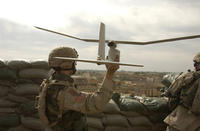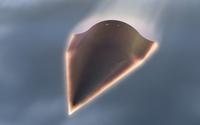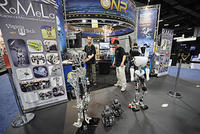-
U.S. military seeking non-lethal UAVs

The U.S. Army is seeking non-lethal warheads to be deployed on tiny UAVs; the U.S. Army describes the possible uses of the non-lethal UAV: “Potential commercial applications might include, but are not limited to: crowd control for local law enforcement; border protection for Homeland Security; or temporary incapacitation of non violent criminals for local SWAT teams and/or law enforcement”
-
-
First U.S. drone attack in Pakistan in a month kills four terrorists
Yesterday, Sunday, missiles launched from a CIA drone missiles hit military targets in Pakistan for the first time in a month. The attack killed four al Qaeda members, but further heightening tensions between the United States and Pakistan. Back in November 2011, U.S. airstrikes, called in by Pakistani commanders n the ground, killed twenty-four Pakistani soldiers. In response, Pakistan said that unless the United States apologized for the incident, no more U.S. drone attack would be allowed against terror targets inside Pakistan. The United States expressed regrets over the death of the soldiers, but refused to apologize, saying the accident was the result of mistakes and miscommunication on both sides. Since November, the United States has reduced considerably the number of drone attacks inside Pakistan, but has refused to end such attacks altogether. The U.S. refusal has led to Pakistani parliament, on three different occasions, to pass resolutions calling upon the United States to cease and desist.
-
-
Surface-to-air missiles to protect London Olympic Games
British security sources revealed that the security envelope developed to protect the Summer Olympic Games in London will include six Rapier surface-to-air missile (SAM) batteries. The British security forces will conduct, between 2 and 10 May, a massive exercise, called Exercise Olympic Guardian, on land, sea, and in the air in the London and Weymouth areas. For those familiar with London: For the exercise, six sites were selected for deployment of the SAM dummies: the Lexington Building in Tower Hamlets; the Fred Wigg Tower in Waltham Forest, east London; Blackheath Common; Oxleas Wood, Eltham; William Girling Reservoir, Enfield; and Barn Hill in Epping Forest.
-
-
NATO prepares for a new, futuristic war
NATO’s Operation Locked Shields, an international military exercise the military alliance conducted last month, was different from trasditional war games. There were no bullets, tanks, aircraft, ships, or camouflage face-paint. The troops involved in the exercise spent most of their time in air-conditioned rooms within a high security military base in Estonia. The exercise, a window into what a future war would look like, had one team of IT specialists detailed to attack nine other teams, located in different parts of Europe. The IT experts, working from their terminals in the Nato Co-operative Cyber Defense Center of Excellence, created viruses, worms, Trojan Horses, and other Internet attacks, aiming to hijack and extract data from the computers of their “enemies.”
-
-
Two Taiwanese nationals charged in military technology smuggling plot

Taiwanese nationals engaged in smuggling counterfeit consumer goods and crystal methamphetamine into the United States, are discovered to be working for Chinese intelligence agencies in an effort to smuggle sensitive U.S. military technology out of the United States
-
-
Review of HTV-2 second test flight concluded

The goal of the Pentagon’s Conventional Prompt Global Strike initiatives is for the U.S. military to have the capability to reach anywhere in the world in less than one hour; a key element of the project is the is Hypersonic Technology Vehicle (HTV-2), which can reach speeds up to twenty times the speed of sound; during an 11 August 2011 flight test, the HTV-2 developed what DARPA describes as “flight anomalies,” which an engineering review board has examined
-
-
New sensor to enable military operations in GPS-denied areas
Many U.S. military systems, such as missiles, rely on the Global Positioning System (GPS) to provide accurate position, orientation, and time information while in flight; a DARPA project seeks an atomic inertial sensor to measure orientation in GPS-denied environments
-
-
DARPA offers $2 million in prizes for Robotic Challenge winners
DARPA is seeking hardware, software, modeling, and gaming developers to link with emergency response and science communities to design robots capable of supervised autonomous response to simulated disaster
-
-
U.S. Navy experience shows climate alterations
The U.S. Navy reports that because of its worldwide presence, it sees the effects of climate change directly; and expert tells a scientific audience at Sandia Lab that disparities in current climate science projections “mean that the Navy should plan for a range of contingencies, given our limited ability to predict abrupt change or tipping points for potentially irreversible change”
-
-
Test strip detects TNT and other explosives in water
Scientists developed a new explosives detector that can sense small amounts of TNT and other common explosives in liquids instantly with a sensitivity that rivals bomb-sniffing dogs, the current gold standard in protecting the public from terrorist bombs
-
-
Army scientists work to improve biothreat detection
A married couple, both scientists working at the U.S. Army’s Edgewood Chemical Biological Center, one of forty-five Biosafety Level 3 labs in the United States; they collaborate on improving the ability of soldiers and first responders to detect, identify, and protect against potentially lethal biological threat agents
-
-
Pentagon explores mind-controlled battle robots

Taking a page from the popular movie Avatar, the military’s advanced research arm DARPA is seeking to develop technology that would allow troops to remotely inhabit the bodies of mechanical androids on the battlefield
-
-
NASA official says hackers gained “full functional control”
Last week NASA officials disclosed details about the alarming extent that hackers were able to penetrate the agency’s networks
-
-
Robot for shipboard firefighting

In both war and peace, fire in the shipboard environment is serious and frequently results in excessive damage and high repair costs because the fire is not detected or controlled adequately; researchershave developed a humanoid robot that could fight fires on the next generation of combatants
-
-
DARPA sponsors development of deep-sea surveillance robot
New Unmanned Underwater Vehicles (UUVs) to address Anti-Submarine Warfare (ASW) surveillance needs over large, operationally demanding areas
-
More headlines
The long view
Bookshelf: Smartphones Shape War in Hyperconnected World
The smartphone is helping to shape the conduct and representation of contemporary war. A new book argues that as an operative device, the smartphone is now “being used as a central weapon of war.”
